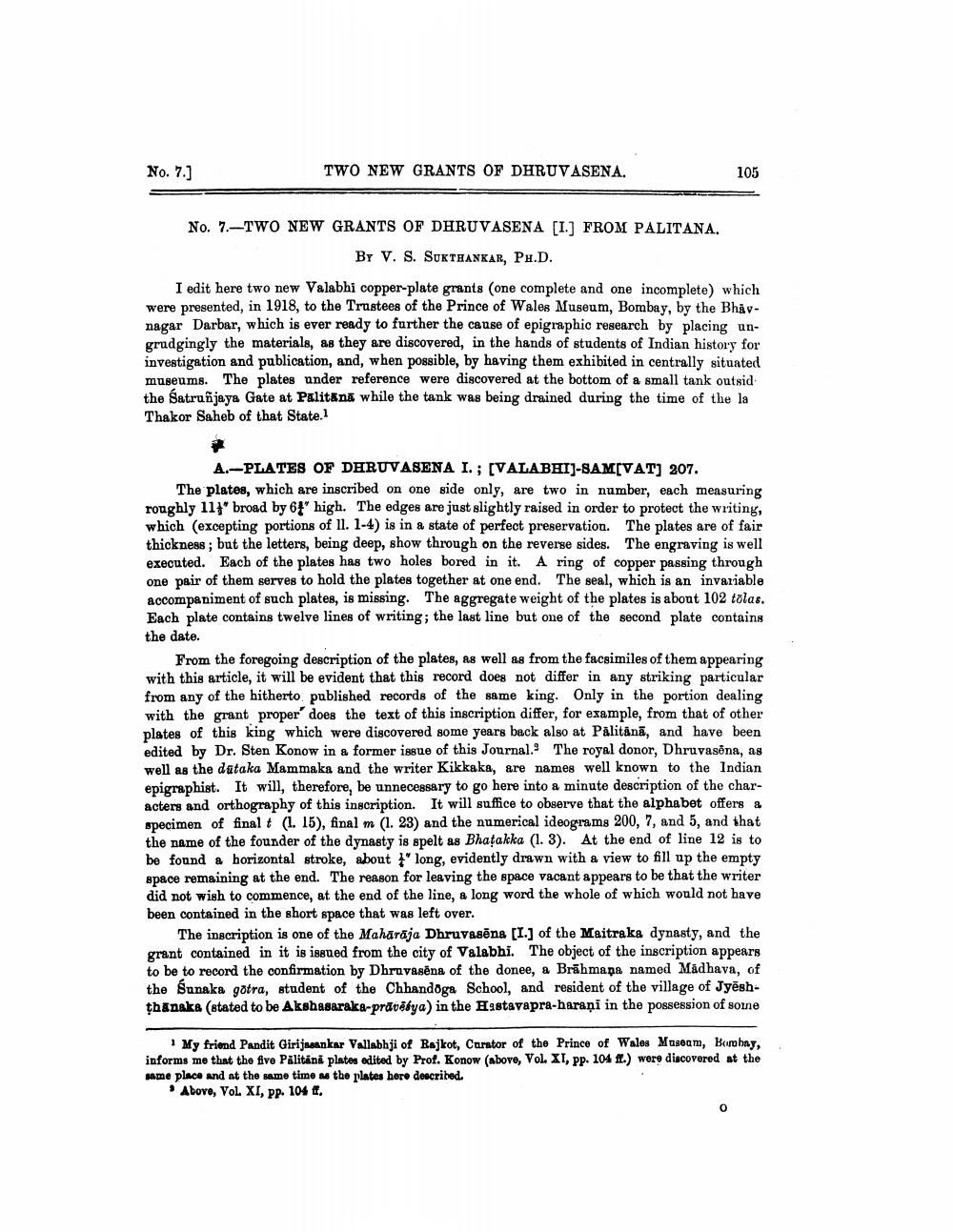________________
No. 7.]
TWO NEW GRANTS OF DHRUVASENA.
105
No. 7.-TWO NEW GRANTS OF DHRUVASENA [1] FROM PALITANA.
BY V. S. SUKTHANKAR, PH.D.
I edit here two new Valabhi copper-plate grants (one complete and one incomplete) which were presented, in 1918, to the Trustees of the Prince of Wales Museum, Bombay, by the Bhavnagar Darbar, which is ever ready to further the cause of epigraphic research by placing ungrudgingly the materials, as they are discovered, in the hands of students of Indian history for investigation and publication, and, when possible, by having them exhibited in centrally situated museums. The plates under reference were discovered at the bottom of a small tank outsid the Satrunjaya Gate at Palitana while the tank was being drained during the time of the la Thakor Saheb of that State.1
A.-PLATES OF DHRUVASENA I.; [VALABHI]-SAM[VAT] 207.
The plates, which are inscribed on one side only, are two in number, each measuring roughly 11" broad by 6" high. The edges are just slightly raised in order to protect the writing, which (excepting portions of 11. 1-4) is in a state of perfect preservation. The plates are of fair thickness; but the letters, being deep, show through on the reverse sides. The engraving is well executed. Each of the plates has two holes bored in it. A ring of copper passing through one pair of them serves to hold the plates together at one end. The seal, which is an invariable accompaniment of such plates, is missing. The aggregate weight of the plates is about 102 tōlas. Each plate contains twelve lines of writing; the last line but one of the second plate contains the date.
From the foregoing description of the plates, as well as from the facsimiles of them appearing with this article, it will be evident that this record does not differ in any striking particular from any of the hitherto published records of the same king. Only in the portion dealing with the grant proper does the text of this inscription differ, for example, from that of other plates of this king which were discovered some years back also at Pālitānā, and have been edited by Dr. Sten Konow in a former issue of this Journal. The royal donor, Dhruvasena, as well as the dataka Mammaka and the writer Kikkaka, are names well known to the Indian epigraphist. It will, therefore, be unnecessary to go here into a minute description of the characters and orthography of this inscription. It will suffice to observe that the alphabet offers a specimen of final t (1. 15), final m (1. 23) and the numerical ideograms 200, 7, and 5, and that the name of the founder of the dynasty is spelt as Bhatakka (1. 3). At the end of line 12 is to be found a horizontal stroke, about " long, evidently drawn with a view to fill up the empty space remaining at the end. The reason for leaving the space vacant appears to be that the writer did not wish to commence, at the end of the line, a long word the whole of which would not have been contained in the short space that was left over.
The inscription is one of the Mahārāja Dhruvasena [I.] of the Maitraka dynasty, and the grant contained in it is issued from the city of Valabhi. The object of the inscription appears to be to record the confirmation by Dhruvasena of the donee, a Brahmana named Madhava, of the Sunaka götra, student of the Chhandōga School, and resident of the village of Jyeshthanaka (stated to be Akshasaraka-pravesya) in the Hastavapra-harani in the possession of some
1 My friend Pandit Girijasankar Vallabhji of Rajkot, Curator of the Prince of Wales Museum, Bombay, informs me that the five Pälitänä plates edited by Prof. Konow (above, Vol. XI, pp. 104 ff.) were discovered at the same place and at the same time as the plates here described.
Above, Vol. XI, pp. 104 ft.




